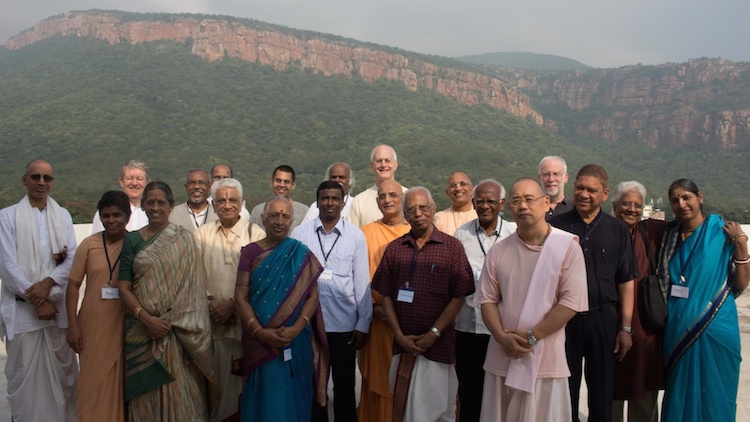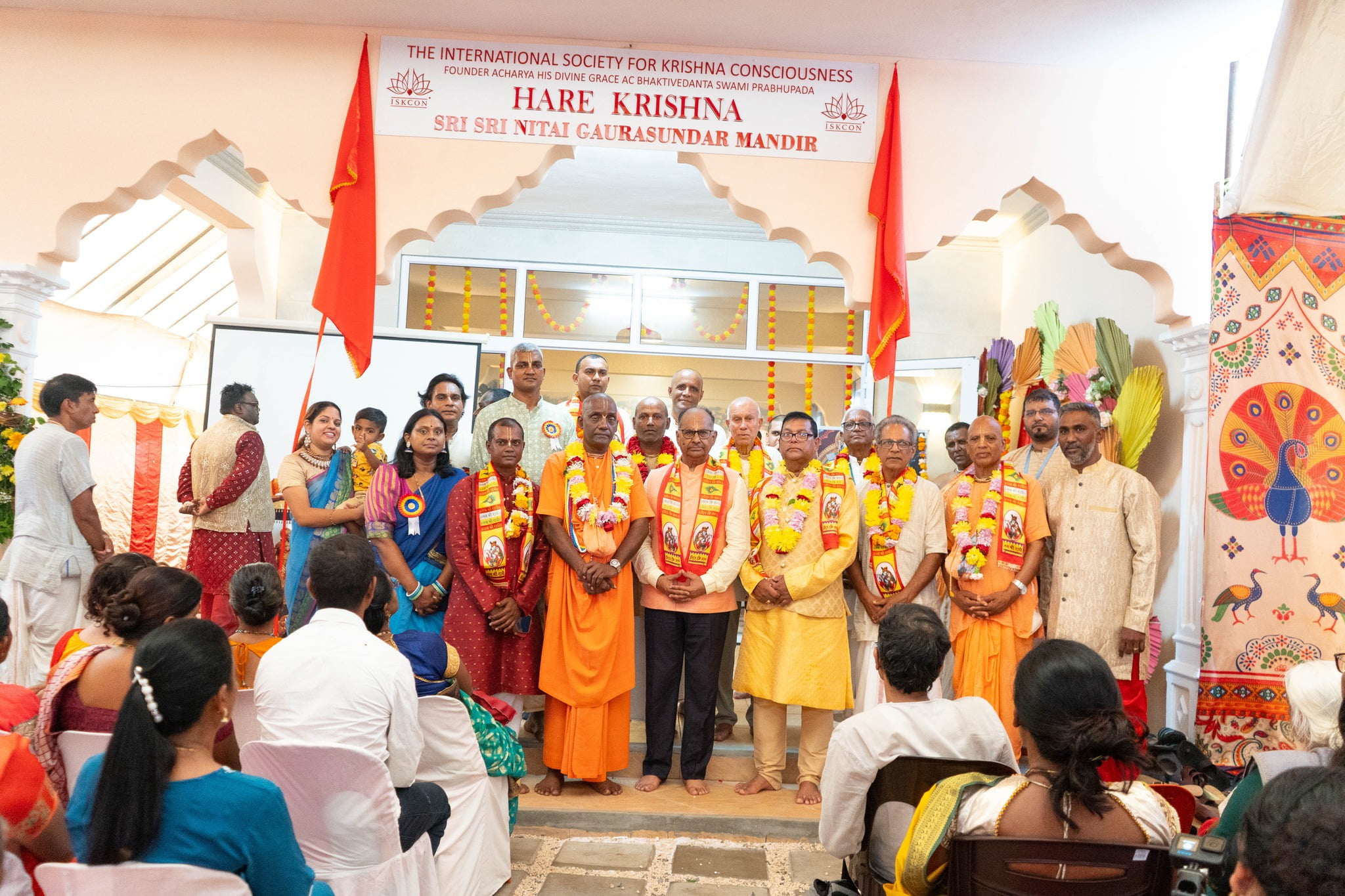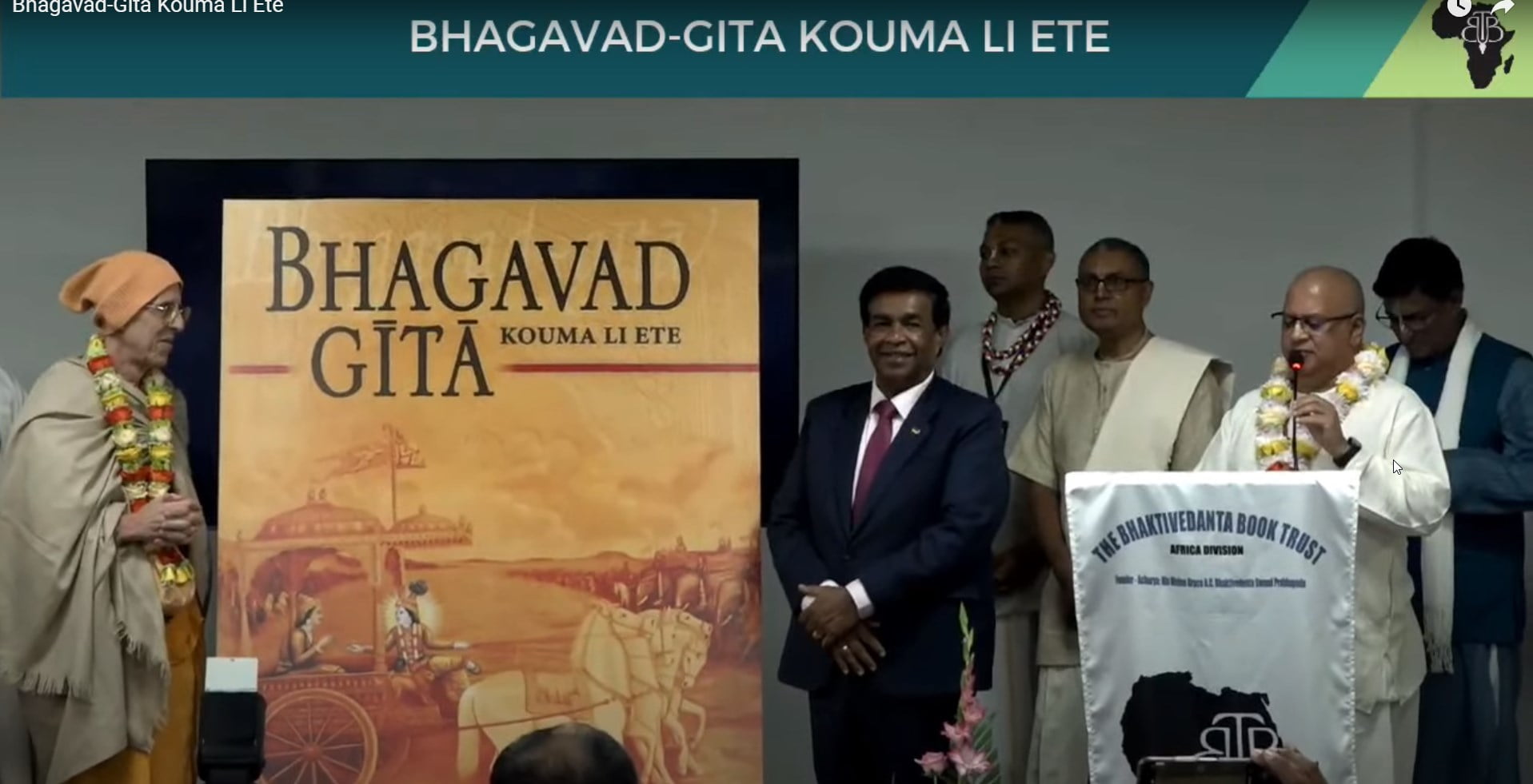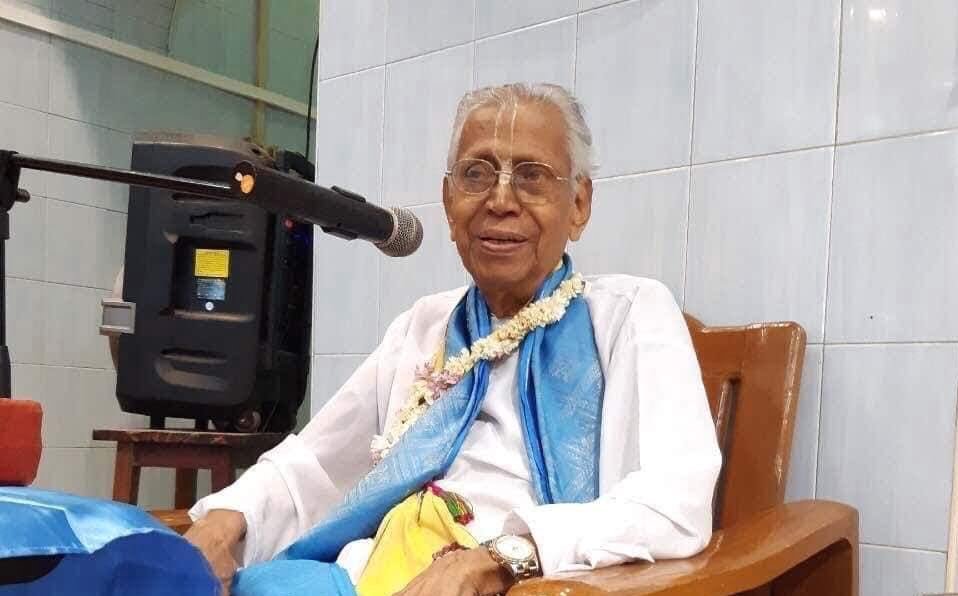ISKCON Hosts First Vaishnava-Christian Dialogue in India
By Madhava Smullen | Jan 15, 2015

Tirupati, India—Twenty men and women of the Christian and Vaishnava traditions met for more than two days of interfaith dialogue in the historic temple town of Tirupati, in Andra Pradesh, India, earlier this month. The event, convened by the ISKCON Communications Ministry, was the first formal Vaishnava-Christian Dialogue ever held in India.
The group was hosted by the ISKCON Tirupati Temple. Its conference rooms overlook the beautiful Tirumala Hills, the seat of the famous Balaji Temple, one of India’s most famous pilgrimage sites.
“One of our Christian friends suggested that we meet in a holy city,” said Anuttama Dasa, Communications Minister and current chair of ISKCON’s Governing Body Commission. “We decided together that Tirupati was the right place due to its spiritual significance, the excellent facilities offered by the ISKCON Temple, and the well-known and gracious hospitality of Temple President Revati Raman and his local team.”

The beautiful Tirumala Hills, as viewed from ISKCON’s Temple Guest House, where participants at the Dialogue were housed.
Being the first Indian dialogue between these two monotheistic traditions, the topics selected were essential to both faiths. The primary theme was “Love of God.” The secondary theme was “Theological Foundations for Dialogue,” in other words, what in each faith allows, or encourages, dialogue with other religions.
In all, nine Christians and eleven Vaishnavas met in Tirupati. They began with an opening session on Sunday evening, January 4, and continued with two full days of dialogue, ending on Tuesday evening, January 6.
Vaishnava representatives included two members of the Sri Vaishnava sampradaya, or denomination. Sri Vaishnavas are followers of Ramanuja Acarya, and they have much in common with ISKCON and the Gaudiya Vaishnava tradition. The Gaudiya tradition was represented by ISKCON devotees including GBC members, three Indian-based sannyasis, the principal of an ISKCON high school in India, a South Indian Temple President, and scholars from the United States and the UK.
Christian participants included a Catholic Archbishop; a Catholic scholar from an American Ivy League school; three Protestant scholars from Christian seminaries in India (who themselves train ministers for Indian churches); a retired eminent Indian Catholic scholar; a Catholic brother who heads a spiritual community founded by Father Bede Griffiths; and nuns specializing in interfaith dialogue.
There were six papers or presentations during dialogue. The discussion on “Love of God”—which filled the entire first day—was inaugurated by four papers on the topic; one each from the Gaudiya Vaishnava, Sri Vaishnava, Catholic Christian and Protestant Christian traditions. On the final day, a Protestant paper and a Gaudiya paper were read on the topic of “Theological Foundations of Dialogue.”

Discussing Bhagavad-gita’s explanation of Love of God.
In his opening remarks on Sunday evening, one Christian professor noted that the most important outcome of such a dialogue was not a document or agreement reached among the parties, but the friendly relationships kindled; relationships that over time can build bridges of understanding and cooperation between these two world traditions.
Parijata dasi, Communications Director for ISKCON in West India, experienced not just new friendships, but a bit of a homecoming as well.
“When I saw the name Sister Theresa listed on the program I was curious,” said Parijata. “When she walked into the room I was amazed to see the very same Sister Theresa who had been my teacher twenty years ago in Convent [Catholic] School in Mumbai,” she said.
During the dialogue Parijata talked about her Convent School experience. “I’m grateful for the education I received,” she said. “The teachers, who were Christian, respected our Hindu culture. During the religion class, the Christian kids were taught about their religion, while the Hindu kids were separately taught about values, morals and such things. Those instructions reinforced what I learned at home and helped to ground me in my life-long Vaishnava convictions.”
Several other Vaishnavas present who attended Convent schools in India—including one Sannyasi—noted their appreciation for the services rendered by the Christian community in India, especially the excellent schools and hospitals.
The non-Indian Vaishnavas present were surprised to learn that a local Christian hospital in Tirupati is held in such high regard that devotees from ISKCON’s headquarters in Mayapura, West Bengal, regularly travel to South India to take advantage of the hospital’s fine medical care and low costs.

Light moments were interspersed with serious theological discussion.
The dialogue was more than friend building, however. Participants were treated to in-depth presentations that explored both similarities and differences between the two traditions.
From the Christian side, a prominent Protestant theologian commented: “I think we Christians can learn from the Vaishnavas about how to love God, and acting in that love. Christians talk about God’s love for us, but you Vaishnavas have a more developed understanding and emphasis on how we can evolve our own love for God.”
Anuttama Dasa commented, “I learned in the dialogue that Jesus taught that the greatest commandments are to love God with all your heart, soul, and mind, and to love your neighbor as yourself. Vaishnavas cultivate a service mentality towards others and the Gita instructs us to be a kind friend to all living beings. But, I think Christians can serve as models for us to do better,” he said.
In his paper on “Theological Foundations of Dialogue from the Vaishnava Perspective,” Anuttama drew from examples of contemporary Gaudiya teachers to point out that dialogue is seen as a positive by the tradition. Srila Bhaktivinode Thakura, a great 19th Century acarya in the Gaudiya tradition, instructed how we should think when visiting a place of worship of another tradition:
“Here is being worshipped my adorable highest entity (God in a different form than that of mine). Due to my practice of a different kind, I cannot thoroughly comprehend this system of theirs, but seeing it, I am feeling a greater attachment for my own system. I bow down with prostration before His emblem as I see here and I offer my prayer to my Lord who had adopted this different emblem that he may increase my love towards Him.” (Sri Caitanya Siksamrita, Chapter 1)
Srila Prabhupada, ISKCON’s Founder-acarya was also quoted, including this statement about the need for interreligious cooperation:
“Hindus, Muslims, Christians and the members of the other sects that have convincing faith in the authority of God must not sit idly now and silently watch the rapid growth of a Godless civilization. There is the supreme will of God, and no nation or society can live in peace and prosperity without acceptance of this vital truth.” (Light of the Bhagavata)

On the last day of the dialogue, participants sat informally in a circle to observe first a Christian and then Vaishnava prayer service.
The Christians present were pleased to learn that Srila Prabhupada had respect for Lord Jesus Christ, considering him to be “our guru,” a Vaishnava, and a saktyavesha empowered representative of the Lord.
On the final day, participants observed two 30-minute prayer services. The Archbishop led a service from the Epiphany, a day connected with the advent of Jesus Christ that comes several days after Christmas. The service included a short talk, or homily, recitation of prayers (some of which—to the delight of the Vaishnavas—spoke of the importance of calling on “the name of the Lord”), and reading from the Old and New Testament of the Bible.
The Vaishnava service was led by ISKCON’s Bhaktivinode Swami and included readings from the Bhagavad-gita and the Srimad Bhagavatam; a reading of the Sisastakam prayers of Lord Caitanya; a short discourse; and a kirtan of the Hare Krishna maha-mantra.
In addition to these sessions, participants shared meals in ISKCON’s Govinda’s Restaurant. It was a site of much interpersonal sharing, philosophizing, story telling, and expressed angst over the general state of religious misunderstanding and conflict around the world.
Before and during the formal dialogue, several participants, both Christian and Vaishnava, took side trips to visit the famed Balaji Temple.
Anuttama: “Although there is tension within India today between religious communities the dialogue demonstrated how much good will can be cultivated when sincere members of the Christian and Vaishnava traditions sit and talk with open hearts and a respectful frame of mind.”
It was also noted that there are areas of the world where the Vaishnava and other Vedic or Hindu traditions are not appreciated, or welcomed, due to sectarianism, misunderstanding, fear, and sometimes the overzealousness of the Vaishnavas themselves. In the same way, there are places where Christianity is not appreciated or welcomed for the same reasons. Worse, such conditions can lead to tension, persecution, and violence against minority faiths, thus threatening the religious freedom of all.
Anuttama added that despite this, sometimes ISKCON devotees don’t appreciate the value of interfaith dialogue, nor that Srila Prabhupada wanted his followers to cultivate friendly dealings with those of other faiths.
“We have much in common, as well as many differences with our Christian neighbors,” Anuttama said. “But, as one of the world’s great monotheistic traditions, we need to share our insights and devotion with others and be prepared to learn from them as well.”
Anuttama concluded: “Too many of the world’s problems are based on religious sectarianism and violence. As Srila Prabhupada’s followers, we must look for ways to work together to promote God consciousness—and how to live peacefully in the world Lord Krishna has provided for us all.”
All of the participants of the Vaishnava Christian Dialogue received a copy of the Bhagavad-gita As-it-Is by A.C. Bhaktivedanta Swami Prabhupada, ISKCON’s official Interfaith Statement (http://www.radha.name/sites/default/files/Interfaith%20Brochure.pdf), and a copy of the Journal of Vaishnava Studies special edition with papers from the seventeen years of Vaishnava-Christian dialogues in the west. (http://iskconcommunications.org/assets/jvs-se.pdf)
Plans have begun to publish the papers from the dialogue, and for a second dialogue in 2016 that will look at theological as well as sociological concerns. All the participants expressed their desire to hold the 2016 dialogue again in Tirupati. As one Christian member noted, it is beautifully “situated in the light of the Tirumala Hills.”












